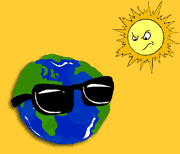Global climate change experts will this week lay out a detailed plan to save the planet from the catastrophic effects of rising temperatures. Climate change could be stopped in its tracks using existing technology, but only if politicians do more to force businesses and individuals to take action.
The UN study will conclude that mankind has the knowhow to reduce global greenhouse gas emissions by as much as 26bn tonnes by 2030 - more than enough to limit the expected temperature rise across the planet to 2-3C.Such a move would cost the world economy billions of pounds over the next two decades, but this could be recouped by savings due to the health benefits of lower levels of air pollution.
Cheaper solutions could bring down emissions to 1990 levels, but that would still see average temperatures rise by as much as 4C this century, with devastating consequences for wildlife, agriculture and the availability of water.
Sector by sector
Transport
Despite breakthroughs in cleaner options, such as hybrid cars, the sector is the fastest growing source of emissions, the report says. It highlights emerging technologies such as cars powered by hydrogen fuel cells and biofuels. The report says government policies such as mandatory carbon dioxide emission standards are crucial, but that hikes in car tax, fuel duty and moves such as road pricing will be less effective as incomes rise. Better public transport can make a significant contribution.
Potential saving by 2030 (million tonnes carbon dioxide equivalent): 3,200
Industry
Industry offers the largest potential savings, although the report acknowledges: "Their implementation requires a stable policy environment that is respecting international competitiveness and includes measures for stimulating technology uptake." The IPCC suggests new controls on industrial pollutants such as methane, nitrous oxide and the chemicals HFCs and PFCs, all potent greenhouse gases. It also says there are big savings for firms who invest in more efficient use of fuels, materials and electricity, combined heat and power systems, and recycling. Heavily polluting industries could benefit from new process technologies that avoid carbon and are expected to come on-stream beyond 2015, it says.
Potential savings: 6,500
Energy supply
More efficient supply, renewable sources, shifts from coal to less polluting gas and nuclear power will play a role in the short to medium term, the IPCC report says. Managing such a transition requires "active policy involvement" such as reducing subsidies for fossil fuels while helping cleaner technology with renewable quotas for power companies and subsidies. The EU has pledged to generate 20% of all energy from renewable sources by 2020. The report says concern over energy security, combined with the development of power infrastructure in the developing world, creates an opportunity to reduce emissions cheaply.
Potential savings: 5,100
Agriculture and forestry
Soils, trees and vegetation provide an important carbon store, and the report says improved land and forestry management offer some of the easiest and cheapest emission savings. "Many options are immediately deployable, do not reduce productivity and have co-benefits," it says. More efficient fertiliser use and better care of crop and grazing land are good too. On forestry, some 65% of the potential carbon savings are in the tropics, and the report says a "combination of afforestation, avoided deforestation and agro-forestry" is the best approach. One major sticking point is whether developing nations such as Brazil and Costa Rica should be paid not to chop down their virgin rainforest.
Potential savings: 6,000
Buildings
Low-cost measures to improve the energy efficiency of buildings could save greenhouse gas emissions and money, the report says. It recommends countries should follow the examples of Germany and Switzerland and force through policies to cut emissions from housing. Appliance standards, building codes, better labelling and procurement procedures for the private sector have worked to cut pollution. Geoffrey Levermore, buildings expert at Manchester University who helped write the report, said: "There's no blue sky technology to revolutionise this industry by giving us a little matchbox that will provide all the energy for your house, but if the right policies are implemented, there are some real savings to be made."
Potential savings: 4,400
Waste
The IPCC says post-consumer waste, such as plastic bags, generates less than 5% of global emissions, but that the rubbish sector can still help to tackle global warming. Recovering methane from landfill sites in the developing world generates more than 15% of carbon credits traded under the Kyoto protocol. Waste management is a key component of wider moves toward sustainable development, it says. Unlike some sectors, the technologies available to reduce emissions from waste are "mature and readily deployable". It adds: "Recycling and waste minimisation provide indirect greenhouse gas mitigation benefits via the conservation of raw materials, and energy from waste offsets fossil fuel consumption."
Potential saving: 1,250





 Homes were evacuated, power was cut and one woman needed hospital treatment after parts of Kent were hit by an earthquake.
Homes were evacuated, power was cut and one woman needed hospital treatment after parts of Kent were hit by an earthquake.


















